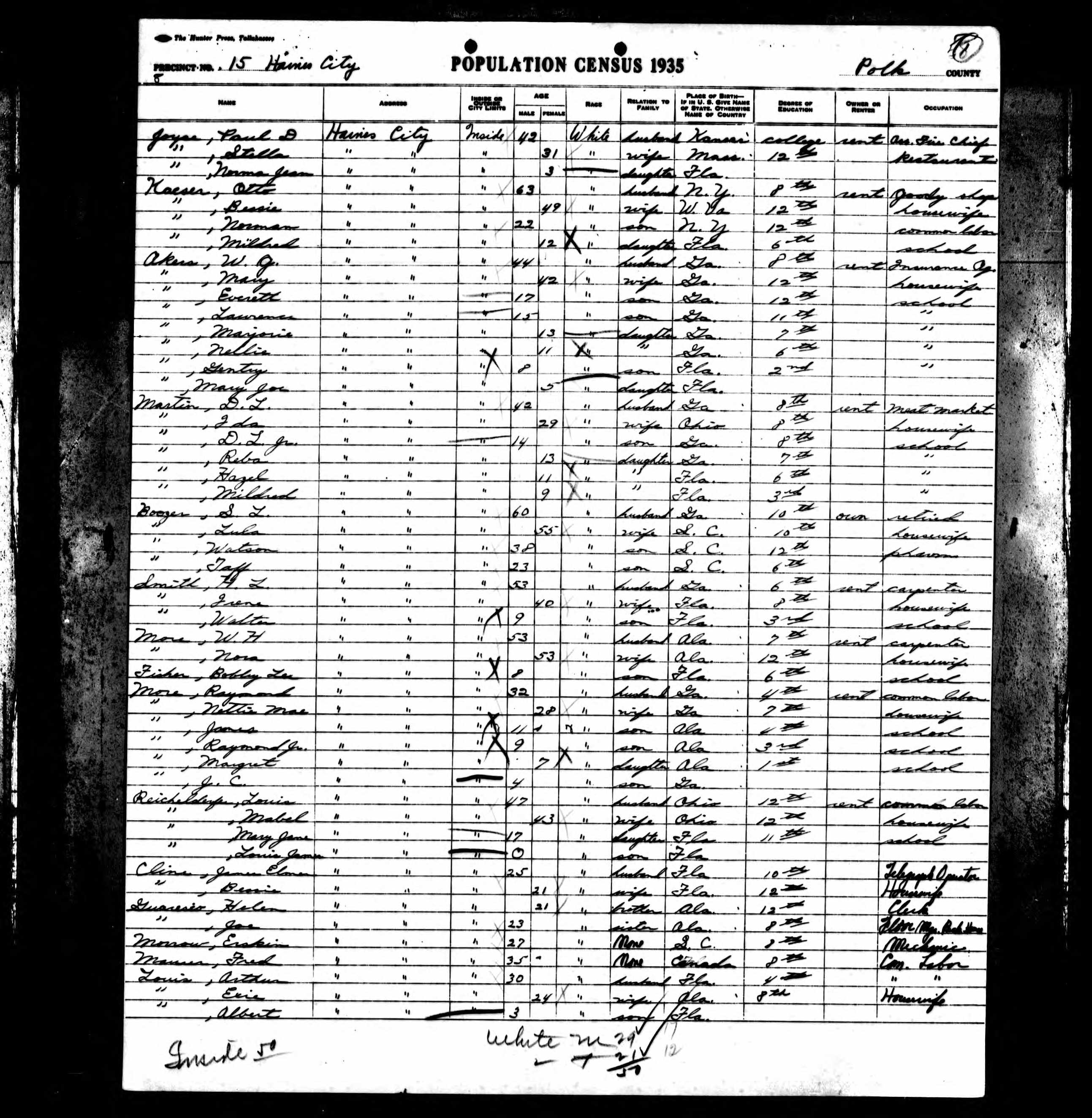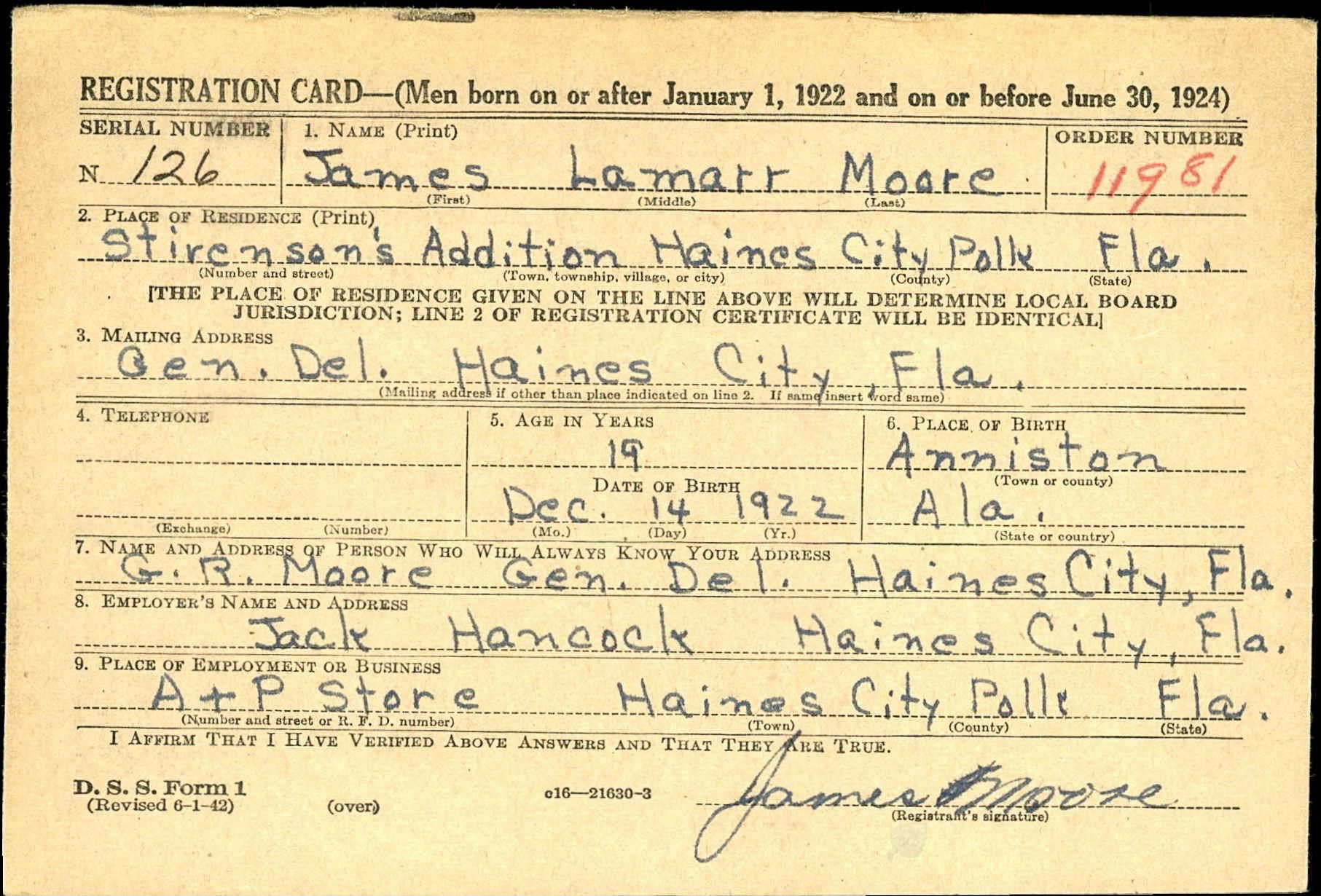James L. Moore (December 14, 1923–June 26, 1994)
Wilma Lorene Moore (May 26, 1924 –August 10, 1988)
By Kaitlin Dressel
Early Life
By Kaitlin Dressel
Early Life
A native of Oxford, Alabama, James Lamarr Moore was the first of eight children born to Raymond R. and Nettie Mae Moore.1 The family moved several times during his childhood. In 1930, according to the US Census, the family lived in Double Run, Georgia, where James’s father Raymond worked as a farmer. By 1935, the family had moved again to Haines City in Polk County, Florida. According to the 1935 Florida Census, James’s father found work as a common laborer.2
As a farm family in the rural South, the Moores felt the brunt of the Great Depression. In 1933, Congress passed the Agricultural Adjustment Act, which paid farmers to reduce their production of crops in exchange for payments from the federal government to benefit both farm landlords and their tenant farmers.3 However, many landlords, rather than paying their tenants a share of the wages, simply dismissed them. The Moore family had to support three children at the time, and the agricultural crisis of Great Depression may have prompted them—like many Southern farm laborers—to move to the city in search of a regular income and steady work. By the 1940 US Census, James’s father held a job as a machine operator at a local plant.4
Growing up in Polk County, James graduated from Haines City High School in the early 1940s and worked as a part-time retail manager at the A&P store in Haines City until his enlistment in the United States Army.5 On October 4, 1942, Moore married Wilma Lorene Rodman in Polk County, Florida.6 Shortly afterward, on January 1, 1943 at the age of 19, Moore was drafted into the US Army and stationed at Camp Blanding, Florida. His draft registration card is seen here.7 Camp Blanding was one of the various camps and forts that arose following the mobilization of troops for combat. Unlike World War I, where combat troops trained to fight in the trenches of France, World War II saw combat fought in jungles, deserts, and mountains in Europe, Africa and Asia, depending on the theater. Thus, soldiers like Moore went through more intense training.8 While Army soldiers served in both theaters, the largest commitment of soldiers went to Europe.9 Regardless of Moore’s particular role in the Army during the war, which is not documented in available public records, the collective efforts of Army soldiers helped secure victory against both the Germans and Japanese.
Military Service
Moore would later serve in the Korean War, a conflict that began after North Korea, supported by the Communist countries of the Soviet Union and China, invaded South Korea on June 25, 1950. The United States led the efforts of the United Nations in supporting the South Koreans, providing over ninety percent of the troops of the United Nations’ forces, military equipment and supplies.10 The United Nations’ troops advanced into North Korea before the Chinese pushed them back into South Korea, eventually turning the war into a stalemate reminiscent of World War I. Ultimately, an armistice stopped the open conflict in 1953, though skirmishes presently continue.11 The troop count from the United States rose from only 510 servicemen before the North Korean invasion to over 326,000 men, bringing soldiers like Moore into the conflict. Moore eventually retired in 1963 with the rank of Major.12
Post-Service Life
Moore spent the rest of his civilian life in Central Florida, settling in Winter Park. He and Wilma eventually had four children: Dewey, Kay, Omaha, and Janice. After his retirement from the military, he owned and operated GEICO Insurance offices in Orlando and Homestead.13 Afterwards, he served as a partner in the Fed Chek organization, where he served as the senior vice president. He and Wilma remained together until her death in 1988 after forty-six years of marriage. Her headstone reads “Together Forever,” revealing the strong and loving marriage the couple had. Five years after Wilma’s death, Moore remarried on March 6th, 1993 to Betty Louise Stallings. He also became a stepfather to her children, Vicki, Diane, and Bobby Stallings.14
James and Betty enjoyed fishing and owned their own small bass boat. One day, they set out on a fishing trip with another couple when a violent storm hit and overturned the boat. The group spent twenty-four hours afloat in the water with James and Betty tethered to their boat and the other couple attempting to swim to shore. Just before two fishermen discovered them, James suffered from heart failure. Efforts to bring the Moores to shore proved successful, but ultimately Moore passed away at Gulf Pines Hospital on June 26, 1994.15 Moore and his first wife, Wilma, are interred, together forever, at the Florida National Cemetery in Bushnell, FL.15
Endnotes
1 U.S., Social Security Applications and Claims Index, 1936-2007," database, Ancestry.com (http://ancestry.com : accessed April 5, 2017) entry for James Lamar Moore
2 “1930 United States Federal Census,” database, Ancestry.com ( http://www.ancestry.com : accessed April 6, 2017), entry for G R Moore, Georgia; “Florida, State Census, 1867-1945,” database, Ancestry.com (http:///ancestry.com : accessed June 12, 2017), entry for James Moore, Tenth census of the state of Florida, 1935.
3 Warren C. Whatley, “Labor for the Picking: The New Deal in the South,” The Journal of Economic History 43, no. 4 (December 1983): 909, http://www.jstor.org/stable/2121055.
4 "United States Census, 1940," database with images, FamilySearch.org, https://familysearch.org (accessed April 6, 2017), entry for James Lamarr Moore, ED 53-45, Haines City, Polk County, Florida.
5 “Electronic Serial Number Merged File, ca. 1938 – 1946 (Enlistment Records),” database, The National Archives, Access to Archival Database (https://aad.archives.gov/aad/record-detail.jsp?dt=893&mtch=1&cat=all&tf=F&q=34538599&bc=&rpp=10&pg=1&rid=4945912 (accessed April 5, 2017), entry for James Lamarr Moore, Army Serial Number 34538599; “U.S. WWII Draft Cards Young Men, 1940-1947,” database, Ancestry.com, https://www.ancestry.com (accessed April 12, 2017), entry for James Lamarr Moore.
6 "Florida Marriage Indexes, 1822-1875 and 1927-2001,” database, Ancestry.com, http://www.ancestry.com (accessed April 5, 2017), entry for James Lamarr Moore and Wilma Lorene Rodman, Polk County, Florida.
7 Elias Huzar, “Selective Service Policy 1940-1942,” The Journal of Politics 4, no. 2 (May 1942): 209, doi:10.2307/2125771; W. D. Perry, “College 18-Year-Olds and the Draft,” The High School Journal 26, no. 1/2 (January-February 1943): 22, http://www.jstor.org/stable/40362155; "United States World War II Army Enlistment Records, 1938-1946," database, FamilySearch.org, https://familysearch.org (December 5, 2014), James L Moore, enlisted 01 Jan 1943, Cp Blanding, Florida, United States.
8 Lee B. Kennett, G. I.: The American Soldier in World War II (New York: Charles Scribner’s Sons, 1987), 48.
9 Ibid., 150.
10 Kathlyn Gay, Martin Gay, and Kathlyn Gay, Korean War, 1st ed, Voices from the Past (New York: Twenty-first Century Books, 1996), 22.
11 Ibid., 254.
12 “Obituaries,” Orlando Sentinel (Orlando, FL), June 30, 1994.
13 Ibid.
14 "Florida Marriage Index, 1822-1875 and 1927-2001," database, FamilySearch.org, https://familysearch.org : accessed April 5, 2017), Betty Louise Stallings, 1993; “Obituaries,” Orlando Sentinel.
15 "Man Drowns, Boat Beached." The Star (Port St. Joe), June 30, 1994, page 1, http://ufdc.ufl.edu/fdnl1.
16 National Cemetery Administration, "James Lamarr Moore" US Department of Veterans Affairs, accessed April 5, 2017, https://gravelocator.cem.va.gov/NGLMap?ID=5456527
© 2017, University of Central Florida




